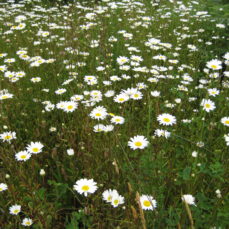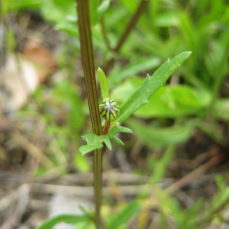Oxeye Daisy (Leucanthemum vulgare)

Management Strategy
Squamish
Whistler
Pemberton
Vectors of Spread
ID Characteristics
General: Upright perennial, growing 0.2 to 1 m tall in dense clumps.
Flowers: White rays and yellow disk flowers (daisy-like), up to 5 cm across. There is a single flower at the end of each branch.
Stems: Multiple, unbranched stems up to 1 m tall. Smooth, frequently grooved, and generally hairless.
Leaves: They grow in an alternate pattern along the stem, decreasing in size. The upper leaves are stalkless with wavy to toothed edges, while the lower leaves are spoon-shaped.
Roots: Shallow, fibrous roots with a creeping rhizome root system.
Similar Species
Invasive
Scentless chamomile (Matricaria perforata) is another invasive plant in the Sea to Sky. Its foliage is much lacier and fern-like. You can learn more about scentless chamomile here.

Scentless Chamomile (SSISC)
Exotic
Shasta daisy (Leucanthemum x superbum): a harmless ornamental, it has a larger yellow disk and white ray flowers. Shasta daisies also grow 15-30cm taller than oxeye daisies.

Photo credit: University of Massachusetts, Amherst
English daisy (Bellis perennis): has much rounder foliage, and the flower petals are often double. English daisies are also generally more compact, and they don’t grow past 15-20cm tall.

Photo credit: Virginia Skilton,E-flora BC
Native
Native asters (Aster spp.) and fleabanes (Erigeron spp.) resemble oxeye daisy but typically have undivided leaf margins without lobes or teeth. Seeds of aster and fleabanes also have a pappus while oxeye daisy seeds do not.

Bitter Fleabane (Erigeron acris). Photo credit: Bryan Kelly-McArthur
Habitat and Origin
Oxeye daisy was introduced from Europe in the early 1800s primarily as a grass seed contaminant, and subsequently spread as an ornamental.
Oxeye daisy resides in moderately dry to dry areas. It prefers disturbed areas, such as roadsides, waste areas, and overgrazed grasslands, as well as pastures and forested areas. In BC, it is common south of the 56th parallel.
How it Spreads
Oxeye daisy spreads both through seeds and vegetatively through underground stems. One plant can produce up to 26,000 seeds, and seeds can remain viable in the soil for many years.
Oxeye daisy is spread by seed, garden waste, machinery, footwear and soil, and can also be accidentally spread through contaminated hay. This species is also sold as an ornamental and in wildflower seed mixes.
Impacts
Ecological:
- Forms dense stands that dominate rangeland, inhibiting forage production.
- Reduces forage for wildlife and livestock; decreases local plant biodiversity.
Economic:
- The impacts of oxeye daisy infestations on the forest industry are not well-known and require further research.
- In terms of economic impact for agriculture, oxeye daisy carries several crop diseases including yellow dwarf virus, which affects potatoes.
Stop the Spread
Oxeye daisy is found in the Sea to Sky region and its distribution is beyond landscape-level control. When oxeye daisy is present at high-priority locations and negatively impacting them, their control is considered a high priority.
Otherwise, the goal is to prevent it from spreading to new (uninfested) areas, and to control it where possible to limit its impact on biodiversity.
Learn to identify oxeye daisy: use the images presented on this profile page to learn how to identify oxeye daisy.
What to do if you spot it: You can report any oxeye daisy sighting by clicking here.
DO:
- Regularly monitor properties for weed infestations.
- Ensure soil and gravel is uncontaminated before transport
- Minimize soil disturbance in area surrounding infestation
- Ensure plants (particularly flowering heads or root fragments) are bagged or covered to prevent spread during transport to designated disposal sites (e.g. landfill).
- Avoid wildflower mixes that contain oxeye daisy.
DO NOT:
- Plant oxeye daisy in a garden, no matter how well-contained its enclosure may seem.
- Move soil that has been contaminated with oxeye daisy.
- Unload, park, or store equipment or vehicles in infested areas; remove plant material from any equipment, vehicles, or clothing used in such areas and wash equipment and vehicles at designated cleaning sites before leaving infested areas.
Control
Cultural Control:
Vegetation cover discourages establishment of oxeye daisy. Planting native vegetation to cover bare soil may help reduce infestations.
Mechanical Control:
Hand-dig before the plants set seed, ensuring that as much root as possible is removed. Mowing prior to seed set can be an effective stopgap method, but should be repeated regularly as it may stimulate vegetation growth. Note that mowing won’t eradicate oxeye daisy, but may prevent it from spreading further.
Chemical Control:
Clopyralid, metsulfuron methyl, picloram and 2,4-D have all proven effective in specific situations. However, picloram is not suitable for wet, coastal soils. We recommend that any herbicide application is carried out by a person holding a valid BC Pesticide Applicator Certificate. Before selecting and applying herbicides, you must review and follow herbicide labels and application rates; municipal, regional, provincial and federal laws and regulations; species-specific treatment recommendations, and site specific goals and objectives.
Biological Control:
No biocontrol agents are currently available for oxeye daisy in BC.
Sea to Sky Distribution
Oxeye Daisy Factsheet
Having trouble viewing the factsheet? Don’t worry, all the information is included on this page. You can also contact us with any questions.
Additional Resources
How to Identify oxeye daisy:
References
- BC Ministry of Transportation and Infrastructure, Best Practices for Managing Invasive Plants on Roadsides
- Electronic Atlas of the Flora of BC, Leucanthemum vulgare
- Invasive Species Compendium, Leucanthemum vulgare
- Invasive Species Council of BC, Oxeye Daisy
- Invasive Species Council of BC, Oxeye Daisy TIPS Factsheet
- Invasive Species Council of Manitoba, Oxeye Daisy Factsheet
- Lillooet Regional Invasive Species Society, Oxeye Daisy
- Okanagan Invasive Species Online (OISO), Oxeye Daisy
- UC Davis, “Leucanthemum vulgare” in Weed Control in Natural Areas in the Western United States










